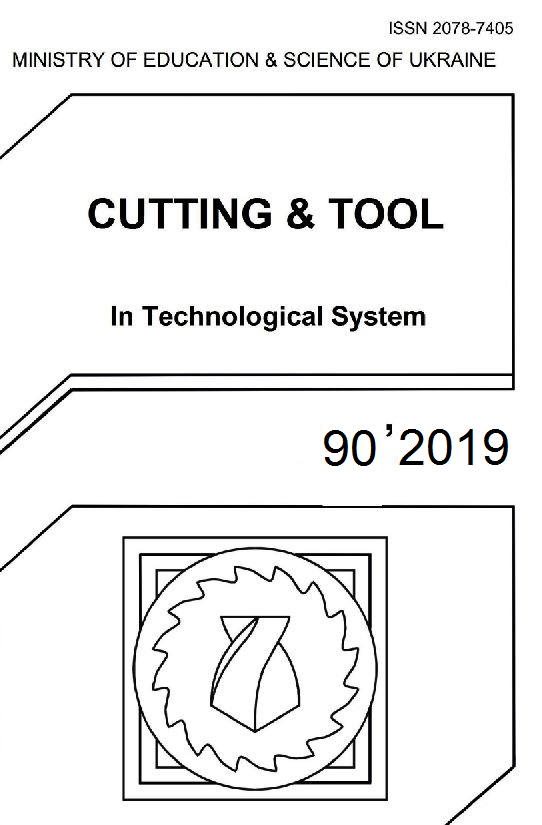INCREASING PRODUCTIVITY OF COMBINED PROCEDURE BY REDUCING GRINDING ALLOWANCE
DOI:
https://doi.org/10.20998/2078-7405.2019.90.04Keywords:
hard machining, combined procedure, gear wheels, operational allowance, surface quality, 3D topography.Abstract
Experiments were carried out to determine the minimal extent of acceptable grinding allowance on case-hardened workpieces machined by combined procedure. The extent of acceptable or unacceptable allowance was determined by a “painting” method. After bore grinding tests for 2D roughness, roundness and 3D topography measurement were carried out. It was found that a 0.03 mm allowance in the bores of gearbox wheels of cars is satisfactory and also necessary to obtain the required level of topography when combined machining was applied and when no white layer formed in the turning procedure. This is a significant finding, because the usual allowances of 0.05 mm or higher (in many cases significantly higher) can be decreased to 0.33 mm and the machining time of bore grinding can be reduced in proportion to this extent.References
Lutjens, P.: Grosse Vorteile durch Kombinationsbearbeitung, Werkstatt und Betrieb 9, 2008, pp.114–119.
Kundrak, J., Deszpoth, I., Molnar, V.: Comparative Examination for the Machining of Hard Surfaces, International Conference on Innovative Technologies: IN-TECH 2012, Rijeka, 2012, pp.305–309. 5 p.
Kundrak, J., Molnar, V. Deszpoth, I.: Comparative Analysis of Machining Procedures, Machines 6(2), 2018, Paper 13, p.6.
Kundrak, J.: Alternative Machining Procedures of Hardened Steels, Manufacturing Technology 11, 2011, pp.32–39.
Klocke, F., Brinksmeier, E., Weinert, K.: Capability Profile of Hard Cutting and Grinding Processes, CIRP Annals - Manufacturing Technology 54 (2), 2005, pp.557–580.
Kundrák, J., Gyáni, K., Deszpoth, I.: The Efficiency of Combined Machinings, Rezanie i Instrumenty v Tekhnologicheskih Sistemah 81, 2012, pp.140–151.
Kundrak, J., Varga, G., Deszpoth, I., Molnar, V.: Some Aspects of the Hard Machining of Bore Holes, Applied Mechanics and Materials 309, 2013, pp.126–132.
Knuefermann, M.M.W., McKeown, P.A.: A Model for Surface Roughness in Ultraprecision Hard Turning, CIRP Annals, 53, 2004pp.99–102.
Kundrak, J., Molnar, V., Deszpoth, I.: Analysis of Machining Time and material Removal Performance as Factors Influencing Efficiency and Profitability, Lecture Notes in Mechanical Engineering, 2018, pp.268–279.
Tonshoff, H.K., Arendt, C., Ben Amor, R.: Cutting of Hardened Steel, CIRP Annals - Manufacturing Technology, 49(2), 2000, pp.547–566.
Dornfeld, D., Lee, D.-E.: Precision Manufacturing, Springer, 2008p.41.
Kosilova, A.G., Mescheryakov, R.K.: Spravochnik tehnologa-mashinostroitelya, Moskva Mashinostroenie, 1985, str.19.
Khonsari, M.M.: Applied Tribology, Wiley, 2008, p65.
Waikar, R.A., Guo, Y.B.: A Comprehensive Characterization of 3D Surface Topography Induced by Hard Turning versus Grinding, Journal of Materials Processing Technology 197, 2008, pp.189–199.
Downloads
Published
Issue
Section
License
Copyright Notice
Authors who publish with this Collection agree to the following terms:
1. Authors retain copyright and grant the Collection right of first publication with the work simultaneously licensed under a Creative Commons Attribution License that allows others to share the work with an acknowledgement of the work's authorship and initial publication in this Collection.
2. Authors are able to enter into separate, additional contractual arrangements for the non-exclusive distribution of the Collection's published version of the work (e.g., post it to an institutional repository or publish it in a book), with an acknowledgement of its initial publication in this Collection.
3. Authors are permitted and encouraged to post their work online (e.g., in institutional repositories or on their website) prior to and during the submission process, as it can lead to productive exchanges, as well as earlier and greater citation of published work.

